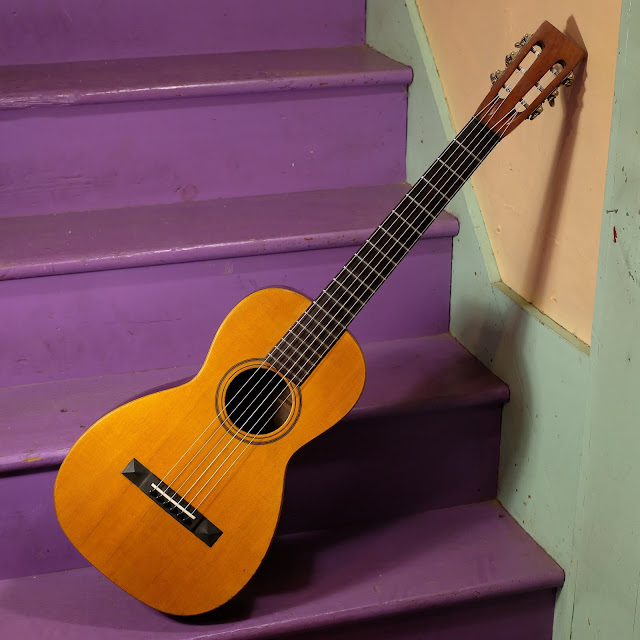1890s Haynes Excelsior Model 101 Parlor Guitar
I've got a soft spot for Haynes-made products. They're built well. They're a little off-kilter in construction compared to modern stuff, but for the time they were consistently-good instruments for their intended use -- as period "classical" or "folk" guitars with gut strings. Folks will often string these up nowadays with steel and watch the poor little boxes go kaboom! ...and also wonder why they sound so thin and compressed while they're doing it, too. Go figure -- if you overdrive the top of a lightly-built guitar you get -- distortion!
Ranting aside, this is a lovely little guitar. It's not even "Martin Size 2" at only 11 1/2" across the lower bout. It's spruce over Brazilian rosewood and, being Model 101, was the most bare-bones of the Excelsior line that one could buy. The serial number at the headstock suggests early-1890s manufacture and that's what it certainly looks like as well.
It was in a bit of rough shape when it came in -- with a screwed-on "neck repair," mucked-up top under the fretboard extension, split-and-poorly-reglued original bridge, and cracks on the top and seams on the sides needing repair.
Work included: a neck reset, fret level/dress, replacement tuners (the originals are damaged), hairline crack cleating/filling repairs to the top, seam repairs to the sides, a new ebony pyramid bridge (StewMac pyramid blank), new ebony bridge pins and endpin, new bone saddle, general cleaning, and a setup with Aquila Nylgut (though any classical strings are fine -- I like Thomastik KR116 sets if I want to "fake" a steel sound) strings. It plays spot-on at 3/32" overall at the 12th fret with plenty of room to come down on the saddle, has a straight neck, and sounds lush. I also cut a "summer saddle" and extra shims that will come with the guitar so it can be adjusted over time.
Scale length: 24 11/16"
Nut width: 1 7/8"
String spacing at nut: 1 11/16"
String spacing at saddle: 2 1/4"
Nut width: 1 7/8"
String spacing at nut: 1 11/16"
String spacing at saddle: 2 1/4"
Body length: 17 3/4"
Lower bout width: 11 1/2"
Upper bout width: 8"
Lower bout width: 11 1/2"
Upper bout width: 8"
Side depth at endpin: 3 3/4"
Top wood: solid spruce
Back/sides wood: solid Brazilian rosewood
Neck wood: Spanish cedar (like mahogany)
Fretboard: rosewood
Back/sides wood: solid Brazilian rosewood
Neck wood: Spanish cedar (like mahogany)
Fretboard: rosewood
Neck shape: 8-10" radius board w/medium-soft-V rear shape
Bridge: good-quality replacement ebony
Nut: replacement bone
Condition notes: five repaired/filled top cracks and a fifth repaired one at the fretboard extension, a couple of tiny-but-stable repaired side cracks on the bass-upper-bout, minor scratching here and there all over, low-ish frets around the nut and body joint, a fretboard extension that "dives" down a bit over the body, and a neck reset that involved both gluing and double-bolting (from the inside) as the joint is of the shallow tenon variety and I never trust it long-term without reinforcement. There's also a filled hole at the back of the heel where someone had installed an external screw in the past.
The ebony nut is original.
Here you can see the somewhat-steep radius to the board. This was very unusual for the time and mostly found only on Haynes/Bay State products concurrently, though I've had a few early Haynes ones with flat boards.
The new bridge looks right at home on the guitar and is only ever-so-slightly wider than the original front-to-back.
How about that Brazilian rosewood? Mmmm-mmm!
The new tuners had to be cut-down individual units to fit into the spacing of the original plates. The old plates from this time had narrower spacing so I couldn't just stick anything repro-style on the guitar without plugging and redrilling the shaft-holes. So, I used these parts-bin Harmony-style tuners (probably from the '50s or early '60s) with their metal buttons to replace the originals. Their ends are cut-down so they snug-together and fit.
While they're not perfect (and certainly not the brass-plate, bone-buttoned originals), they do look a lot like the old nickel-buttoned Weymann-style tuners used just a touch later, so at a glance they look "right."





















Comments